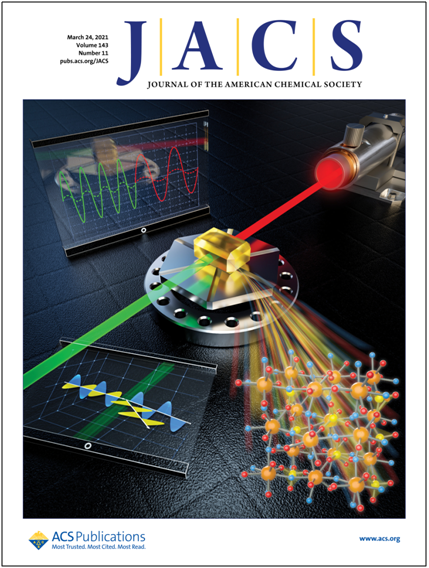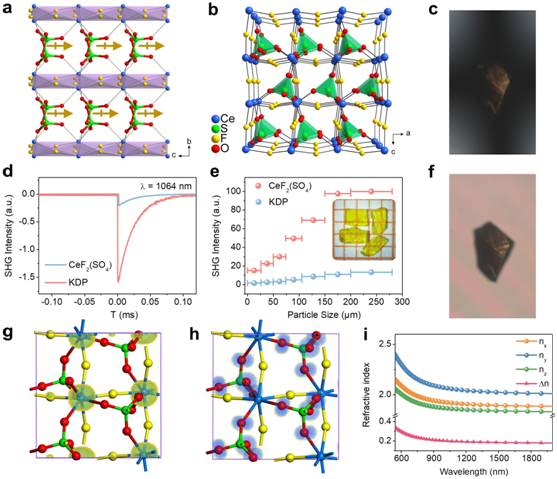The nonlinear optical crystal material is an important functional material for opto-electronic information technology, which is an important material basis for realizing modern information technology with opto-electronic technology as its core. It has important value and application potential in such fields as laser frequency conversion, optical signal processing, optical communication and optical switch. With the rapid development of modern optical technology, the research and development of high-performance nonlinear optical crystal materials is an effective strategy to cope with the urgent needs in laser technology. The optical second-harmonic generation (SHG) response and birefringence are two crucial performance indicators of nonlinear optical materials, but the two have very different structural requirements for the microstructure of crystalline materials. At present, most tetrahedron-based oxides (such as phosphate, sulfate and silicate) that have been found so far generally have either weak second-order nonlinear optical effect or small birefringence, which substantially limits their practical application in laser technology. Obtaining oxide crystalline materials with simultaneously and significantly optimized gain of the optical SHG response and birefringence is a scientific challenge in the current research of nonlinear optical materials.
Professor ZHANG Chi’s research team from the School of Chemical Science and Engineering of Tongji University, in cooperation with Beijing Technical Institute of Physics and Chemistry, Chinese Academy of Sciences (CAS), and Fujian Institute of Research on the Structure of Matter, CAS, taking non-p-conjugated sulfates that have environmental-friendly chemical composition, wide optical transmission range and easy growth environment for crystal to as study objects, has proposed a strategy to improve the structural distortion of crystalline materials by introducing the fluorinated rare-earth metal centered polyhedra based on the non-second-order Jahn-Teller effect, and designed and created a high-valent rare-earth metal cerium fluorinated sulfate crystalline material with a strong SHG effect and giant birefringence. The relevant result “Large Second-Harmonic Response and Giant Birefringence of CeF2(SO4) Induced by Highly Polarizable Polyhedra” was recently published as Communication in the Journal of the American Chemical Society (J. Am. Chem. Soc. 2021, 143 (11), 4138-4142), the most important academic journal in the field of international chemistry, and was selected as the cover story of the latest issue of the journal by the JACS Editorial Board because of the important and innovative nature of the research work and the high recognition by peer experts.

In this study, the team has proposed for the first time a strategy to increase structural distortion by introducing the fluorinated rare-earth metal centered polyhedral based on the non-second-order Jahn-Teller effect as a method to enhance nonlinear optical response and birefringence. Unlike second-order Jahn-Teller metal cations, local 4f electronic rare-earth metal cations induce significant differences in energy band structure, thereby potentially improving the linear and nonlinear optical properties of materials; the introduction of highly electronegative fluoride ions into rare-earth central polyhedra facilitates the formation of highly-polarized optical active architectural elements, which improves the SHG effect and optical anisotropy of materials; tetrahedral anion groups regulated by polarized metal central polyhedra show enhanced optical anisotropy and polarizability when they are uniformly aligned, which helps maximize the SHG response and birefringence at the same time. Based on this distortion-enhancing strategy, the first three-dimensional tetravalent rare-earth metal cerium fluorosulfate CeF2(SO4) composed of highly polarizable polyhedron [CeO4F4] and tetrahedron [SO4]2- has been successfully designed and created.
The team has also applied density functional theory, combined with X-ray diffraction analysis of single crystal structure of the material, to perform theoretical simulation calculation, further explored and elucidated the intrinsic physical mechanism of CeF2(SO4) with simultaneous optimization of the gain of the strong SHG response and giant birefringence, and proposed that the gain of strong SHG response and giant birefringence is promoted mainly due to the introduction of highly polarized cerium fluoride oxygen polyhedron [CeO4F4] and the optimal orderly arrangement and dense accumulation of rare-earth metal polyhedron and [SO4]2- tetrahedral elements. CeF2(SO4), a high-valent rare-earth metal cerium fluorosulfate crystal, shows a strong SHG response (8.0 × KDP), and its SHG intensity is the maximum among the inorganic sulfate systems found so far; the birefringence of CeF2(SO4) (0.361 @ 546 nm) exceeds the limit value of birefringence of oxides reported so far. This study provides a new demonstration for the design and creation of new high-performance nonlinear optical crystal materials.

At the same time, the team has recently made important progress in the creation of UV second-order nonlinear optical oxide crystals. They have constructed the first 2D composite rare-earth metal iodate-nitrate crystal material Sc(IO3)2(NO3) by employing an equivalent oxyanion substitution strategy, which achieves great optical anisotropy in the UV band (0.348 @ 546 nm) and demonstrates that the composition of two oxyanion (p-conjugated [NO3]- and lone pair electron-containing [IO3]- provides optical anisotropy and SHG response on the gain of crystalline materials as compared with traditional single oxyanion metal oxides. Related work was published in Angewandte Chemie International Edition (2021, 60 (7), 3464-3468).
The above research works have been supported by the Key Program of the National Natural Science Foundation of China, the Innovation Team of Chang Jiang Scholars Program of the Ministry of Education, the Innovation Team of Key Areas of the Ministry of Science and Technology, the Program of Introducing Talents of Discipline to Universities of the Ministry of Education and State Administration of Foreign Experts Affairs, and the Key Innovation Program of the Shanghai Municipal Education Commission. Professor ZHANG Chi is the corresponding author of the series of papers; Dr. WU Chao and doctoral student WU Tianhui are the co-first authors of the papers, and Professor HUANG Zhipeng of our University participated in some relevant research work.
Link to the article: https://pubs.acs.org/doi/10.1021/jacs.1c00416?ref=pdf